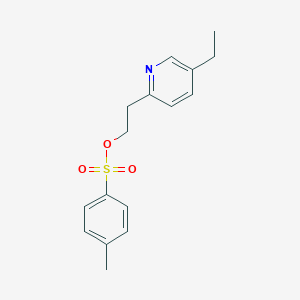
5-Ethyl-2-pyridineethanol Tosylate
- Haga clic en CONSULTA RÁPIDA para recibir una cotización de nuestro equipo de expertos.
- Con productos de calidad a un precio COMPETITIVO, puede centrarse más en su investigación.
Descripción general
Descripción
5-Ethyl-2-pyridineethanol Tosylate is a chemical compound belonging to the class of tosylates. Tosylates are esters of p-toluenesulfonic acid and are commonly used in organic synthesis due to their excellent leaving group properties. This compound is particularly interesting due to its unique structure, which includes a pyridyl group, making it valuable in various scientific research applications.
Métodos De Preparación
Synthetic Routes and Reaction Conditions
The synthesis of 5-Ethyl-2-pyridineethanol Tosylate typically involves the tosylation of 2-(5-Ethyl-2-pyridyl)ethanol. The reaction is carried out using p-toluenesulfonyl chloride (TsCl) in the presence of a base such as pyridine or triethylamine. The reaction is usually conducted at room temperature or slightly elevated temperatures to ensure complete conversion.
Industrial Production Methods
Industrial production of this compound follows similar synthetic routes but on a larger scale. The process involves the use of large reactors and precise control of reaction conditions to ensure high yield and purity. The product is then purified using standard techniques such as recrystallization or chromatography.
Análisis De Reacciones Químicas
Types of Reactions
5-Ethyl-2-pyridineethanol Tosylate undergoes various types of chemical reactions, including:
Nucleophilic Substitution Reactions: Due to the excellent leaving group properties of the tosylate group, it readily undergoes nucleophilic substitution reactions with a variety of nucleophiles.
Reduction Reactions: The compound can be reduced to form the corresponding alcohol or amine derivatives.
Oxidation Reactions: It can also undergo oxidation reactions to form various oxidized products.
Common Reagents and Conditions
Nucleophilic Substitution: Common reagents include sodium azide, potassium cyanide, and various amines.
Reduction: Common reducing agents include lithium aluminum hydride (LiAlH4) and sodium borohydride (NaBH4).
Oxidation: Common oxidizing agents include potassium permanganate (KMnO4) and chromium trioxide (CrO3).
Major Products
The major products formed from these reactions depend on the specific conditions and reagents used. For example, nucleophilic substitution reactions can yield a variety of substituted pyridyl derivatives, while reduction reactions typically yield alcohols or amines .
Aplicaciones Científicas De Investigación
5-Ethyl-2-pyridineethanol Tosylate has a wide range of applications in scientific research:
Chemistry: It is used as an intermediate in the synthesis of various organic compounds, including pharmaceuticals and agrochemicals.
Biology: The compound is used in the study of biological systems, particularly in the synthesis of biologically active molecules.
Industry: The compound is used in the production of polymers and other industrial materials.
Mecanismo De Acción
The mechanism of action of 5-Ethyl-2-pyridineethanol Tosylate primarily involves its role as a leaving group in nucleophilic substitution reactions. The tosylate group is easily displaced by nucleophiles, facilitating the formation of new chemical bonds. This property makes it a valuable intermediate in various synthetic processes .
Comparación Con Compuestos Similares
Similar Compounds
- 2-(2-Pyridyl)ethyl Tosylate
- 2-(4-Ethyl-2-pyridyl)ethyl Tosylate
- 2-(5-Methyl-2-pyridyl)ethyl Tosylate
Uniqueness
5-Ethyl-2-pyridineethanol Tosylate is unique due to the presence of the ethyl group at the 5-position of the pyridyl ring. This structural feature can influence the compound’s reactivity and its interactions with other molecules, making it distinct from other similar tosylates .
Propiedades
IUPAC Name |
2-(5-ethylpyridin-2-yl)ethyl 4-methylbenzenesulfonate |
Source


|
|---|---|---|
| Source | PubChem | |
| URL | https://pubchem.ncbi.nlm.nih.gov | |
| Description | Data deposited in or computed by PubChem | |
InChI |
InChI=1S/C16H19NO3S/c1-3-14-6-7-15(17-12-14)10-11-20-21(18,19)16-8-4-13(2)5-9-16/h4-9,12H,3,10-11H2,1-2H3 |
Source


|
| Source | PubChem | |
| URL | https://pubchem.ncbi.nlm.nih.gov | |
| Description | Data deposited in or computed by PubChem | |
InChI Key |
XOKOJAMQAAPMRF-UHFFFAOYSA-N |
Source


|
| Source | PubChem | |
| URL | https://pubchem.ncbi.nlm.nih.gov | |
| Description | Data deposited in or computed by PubChem | |
Canonical SMILES |
CCC1=CN=C(C=C1)CCOS(=O)(=O)C2=CC=C(C=C2)C |
Source


|
| Source | PubChem | |
| URL | https://pubchem.ncbi.nlm.nih.gov | |
| Description | Data deposited in or computed by PubChem | |
Molecular Formula |
C16H19NO3S |
Source


|
| Source | PubChem | |
| URL | https://pubchem.ncbi.nlm.nih.gov | |
| Description | Data deposited in or computed by PubChem | |
DSSTOX Substance ID |
DTXSID10460656 |
Source


|
| Record name | 2-(5-Ethyl-2-pyridyl)ethyl Tosylate | |
| Source | EPA DSSTox | |
| URL | https://comptox.epa.gov/dashboard/DTXSID10460656 | |
| Description | DSSTox provides a high quality public chemistry resource for supporting improved predictive toxicology. | |
Molecular Weight |
305.4 g/mol |
Source


|
| Source | PubChem | |
| URL | https://pubchem.ncbi.nlm.nih.gov | |
| Description | Data deposited in or computed by PubChem | |
CAS No. |
144809-27-8 |
Source


|
| Record name | 2-(5-Ethyl-2-pyridyl)ethyl Tosylate | |
| Source | EPA DSSTox | |
| URL | https://comptox.epa.gov/dashboard/DTXSID10460656 | |
| Description | DSSTox provides a high quality public chemistry resource for supporting improved predictive toxicology. | |
Descargo de responsabilidad e información sobre productos de investigación in vitro
Tenga en cuenta que todos los artículos e información de productos presentados en BenchChem están destinados únicamente con fines informativos. Los productos disponibles para la compra en BenchChem están diseñados específicamente para estudios in vitro, que se realizan fuera de organismos vivos. Los estudios in vitro, derivados del término latino "in vidrio", involucran experimentos realizados en entornos de laboratorio controlados utilizando células o tejidos. Es importante tener en cuenta que estos productos no se clasifican como medicamentos y no han recibido la aprobación de la FDA para la prevención, tratamiento o cura de ninguna condición médica, dolencia o enfermedad. Debemos enfatizar que cualquier forma de introducción corporal de estos productos en humanos o animales está estrictamente prohibida por ley. Es esencial adherirse a estas pautas para garantizar el cumplimiento de los estándares legales y éticos en la investigación y experimentación.
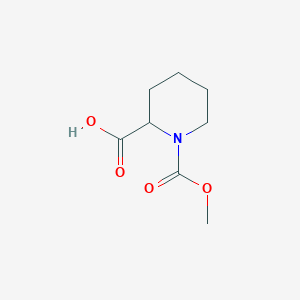
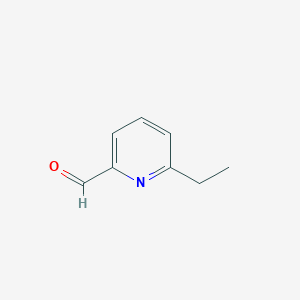
![6-Chloro-2,2,3,3-tetrafluoro-2,3-dihydro-benzo[1,4]dioxine](/img/structure/B138975.png)
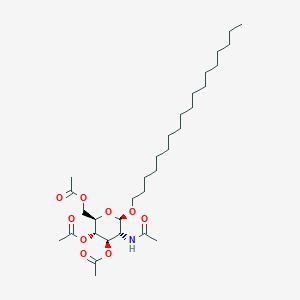
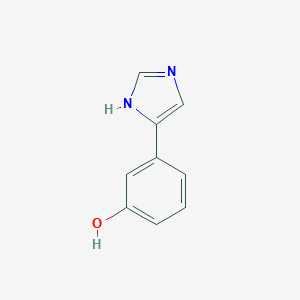
![N,N'-([1,2,5]Oxadiazolo[3,4-b]pyrazine-5,6-diyl)bis(hydroxylamine)](/img/structure/B138993.png)
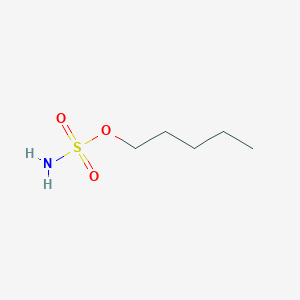
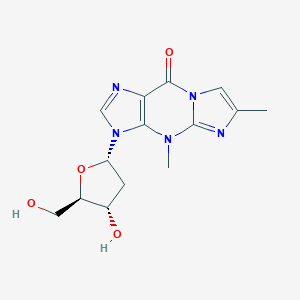


![1-Ethyl-2-([7-([1-ethylnaphtho[1,2-D][1,3]thiazol-2(1H)-ylidene]methyl)-4,4A,5,6-tetrahydro-2(3H)-naphthalenylidene]methyl)naphtho[1,2-D][1,3]thiazol-1-ium iodide](/img/structure/B139002.png)

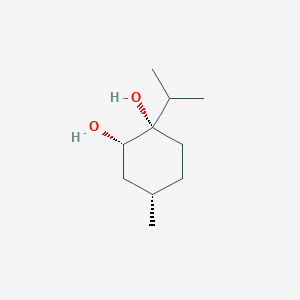
![(4S)-4-[[(1,1-Dimethylethoxy)carbonyl]amino]-5-hydroxypentanoic acid ethyl ester](/img/structure/B139007.png)
